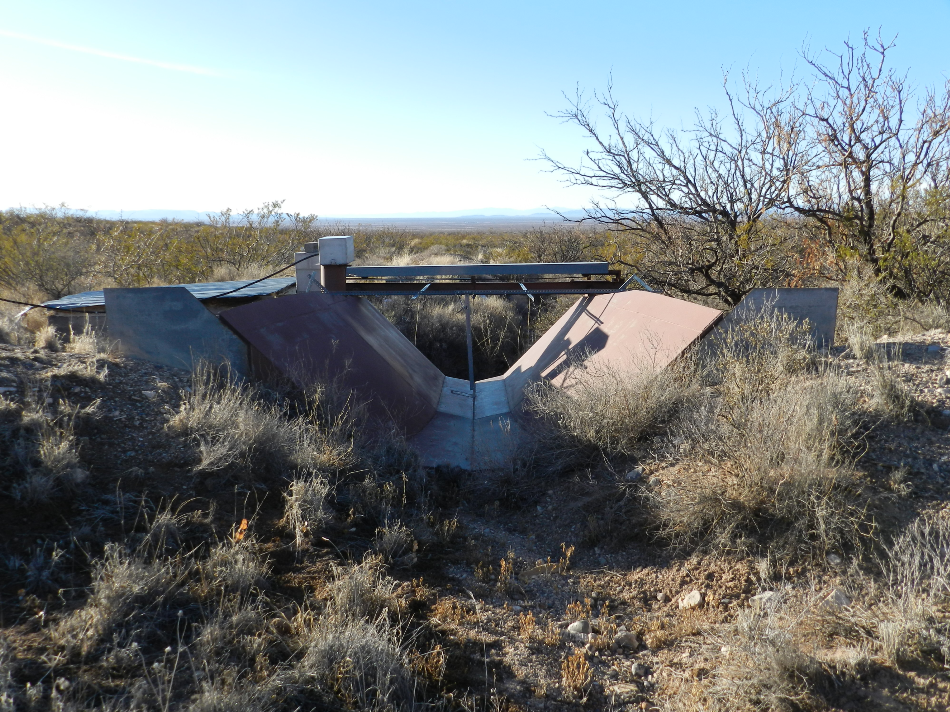May 18 2020
Worldwide, grasslands that feed a majority of the grazing animals have been changing into shrublands in a so-called “woody plant encroachment.”
 The flume at the outlet of the watershed that measures streamflow. Image Credit: Adam Schreiner-McGraw/UC Riverside.
The flume at the outlet of the watershed that measures streamflow. Image Credit: Adam Schreiner-McGraw/UC Riverside.
Controlled grazing of drylands is the most comprehensive form of land use on Earth, resulting in large-scale efforts to reverse this trend and revive grass cover because of the opinion that it leads to less water entering groundwater aquifers and streams.
Led by Adam Schreiner-McGraw, a postdoctoral hydrology researcher at the University of California, Riverside, a new study has now modeled shrub encroachment on a sloping landscape and arrived at a shocking conclusion.
The study concludes that encroachment of shrubs on slopes can increase the quantity of water that reaches the groundwater storage. The shrubs have such a powerful impact that even the lower annual rainfall amounts predicted during climate change are counterbalanced.
To date, scientists have considered that since woody plants such as shrubs and trees have deeper roots compared to grass, encroachment by woody plants led to the entry of less water into groundwater aquifers and streams. This belief originated from researchers’ related analyses on flat ground.
It is striking that ecosystem composition is what controls projected future changes to groundwater recharge. This does not mean that climate change is not important, but that vegetation change is potentially more important and something that scientists and land managers should focus more effort on understanding.
Adam Schreiner-McGraw, Postdoctoral Hydrology Researcher, University of California, Riverside
According to Hoori Ajami, co-author of the study and an assistant professor of groundwater hydrology at UC Riverside, the study analyzes the combined effects of vegetation change and climate on groundwater-recharge processes in arid environments.
“Most studies to date have looked at these changes in isolation,” noted Ajami. “Here we illustrate that the combined effects of vegetation change and climate change could be greater or less than the sum of its parts.”
In general, the encroachment of shrubs into grasslands is regarded as an issue since it decreases the quantity of forage available for livestock grazing and could result in more bare ground patches and consequent increase in soil erosion. This process of developing more bare ground is known as “xerification.” Although climate change plays a role in xerification, overgrazing and fire suppression play the most crucial roles.
The fact that shrubs—with thick stems, deep root systems, and many leaves—capture more water compared to grass as it percolates down through the soil, is logical, it leaves less water available to replenish the underground aquifers.
Studies on “diffuse recharge,” the process through which groundwater supplies are replenished by water over a wider area, appears to bear this out for flat landscapes. Xerification of grasslands has been regarded as detrimental for both the water cycle and livestock.
We approached this research with a simple premise that topography plays a role in redistributing available water, and this should affect the outcomes of xerification.
Enrique R. Vivoni, Study Co-Author and Professor, Arizona State University
The researchers studied focused recharge, which takes place when water is funneled by hillslopes into concentrated areas such as streambeds. In general, streambeds feature sandy bottoms, which enable quick infiltration of water and prevent sucking of water by the deep-rooted shrubs.
The researchers used data collected from a highly tracked desert mountain slope in New Mexico to mimic the impacts of the encroachment of woody plants and climate change on water resources. They found that the shrubs increased focused recharge of groundwater even under conditions in which the amount of rainfall was reduced due to climate change.
In addition, the team modeled a more comprehensive form of shrub encroachment known as thicketization, where plants grow in dense stands without any no bare patches. Similar to earlier flat landscape study, they discovered that the shrubs also decreased the amount of groundwater recharge on slopes.
Bare soil is essential in between patches of shrubs on hillslopes to drive water into streambeds. Increased runoff improves the focused recharge of groundwater.
“We were surprised to find that a transition from grassland to shrubland can increase sustainability of groundwater aquifers,” explained Schreiner-McGraw. “The best way to increase focused recharge in this system is to increase the amount of runoff from hillslopes that gets concentrated in the streambeds.”
Climate change may increase the recharge of groundwater with larger but less frequent rainstorms. During larger storms, the quantity of runoff that reaches sandy-bottom channels increases, raising the recharge of groundwater.
The outcomes of this study indicate that vegetation will also play a crucial role in groundwater recharge in the future.
According to Schreiner-McGraw, although the study was performed in New Mexico, it is applicable to similar environments. Major portions of California are also desert savannahs. Southern California and the Central Valley include landforms such as those found in the New Mexico research site.
Such areas could undergo analogous hydrological processes, despite the fact that atmospheric rivers develop storms quite different from monsoon storms. Therefore, more studies are needed.
The study highlights the role of long-term monitoring in understanding water balance dynamics of watersheds, and the role that process-based modeling plays in understanding system dynamics.
Hoori Ajami, Study Co-Author and Assistant Professor of Groundwater Hydrology, University of California, Riverside
The paper titled “Woody Plant Encroachment has a Larger Impact than Climate Change on Dryland Water Budgets” has been published in Nature Scientific Reports. Other authors of the study are Osvaldo E. Sala and Heather L. Throop of Arizona State University, and Debra P.C. Peters from the USDA Agricultural Research Service.
Journal Reference:
Schreiner-McGraw, A. P., et al. (2020) Woody Plant Encroachment has a Larger Impact than Climate Change on Dryland Water Budgets. Nature Scientific Reports. doi.org/10.1038/s41598-020-65094-x.